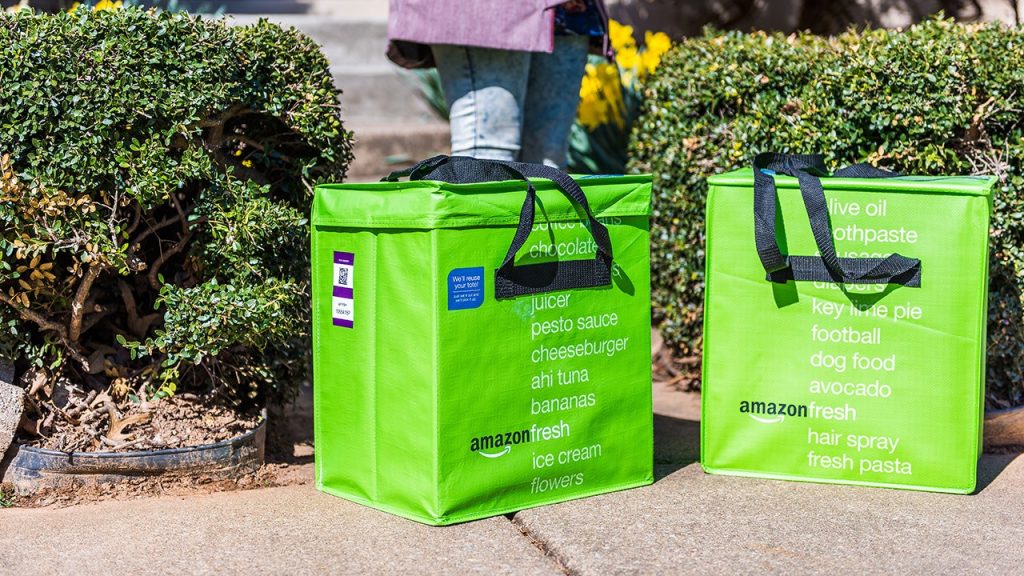Key takeaways
- With Amazon’s Prime Big Day Deals fast approaching this summer, now is a great time to sign up for an Amazon credit card.
- Among the options are cards that offer welcome bonuses upon approval and high ongoing rewards for everyday purchases.
- Choosing between the Amazon Prime Store Card and the Amazon Prime Visa depends on which perks you want and whether you want to earn rewards on all your purchases or just your Amazon-related purchases.
The best credit cards for shopping on Amazon let users earn the top rewards rate on everything they buy from Amazon and its associated brands, like Whole Foods. That said, there’s more than one Amazon credit card to consider, so you’ll need to do some research before you apply. And if you’re planning to take advantage of Amazon Prime Big Day Deals in the first half of July, you’ll want to act fast.
When it comes to store cards — that is those for use within the limited Amazon universe — Synchrony Bank offers the Amazon Prime Store Card. If you’re looking for a card to use for purchases with Amazon and beyond, Chase offers the Prime Visa (formerly known as the Amazon Prime Rewards Visa Signature Card).
Main Details
Although both the Amazon store card and the Amazon Visa can enhance your shopping experience, it’s good to know which Amazon card is best for your financial situation and Amazon shopping habits. Essentially, your card of choice will boil down to your credit score, how often you shop on Amazon and whether you’re an Amazon Prime member. Here’s a quick guide to these two Amazon credit card options to help you choose the best one for your lifestyle.
| Amazon Prime Store Card | Prime Visa | |
|---|---|---|
| Rewards rate |
|
|
| Sign-up bonus | $10 Amazon gift card upon approval | $100 Amazon gift card upon approval |
| Annual fee | $0 (but requires $139 Amazon Prime membership) | $0 (but requires $139 Amazon Prime membership) |
| Card perks |
|
|
Amazon Prime Store Card vs. Prime Visa: Highlights
Synchrony and Chase offer two separate versions of Amazon Prime credit cards that differ mainly in the type of rewards they offer and where you can use the card. Chase offers the open-loop Amazon Prime Visa Card — meaning you can use it for more than just Amazon. Synchrony offers the closed-loop Amazon Prime Store Card, which means you can only use it on Amazon-related purchases. Here’s how the two cards compare to each other:
Welcome bonus winner
-
A $100 gift card is worth more than a $10 gift card — plain and simple. Considering that both cards only require approval to earn the welcome bonus rather than spending a certain amount like a typical credit card offer, there’s no simpler way to make $100.
Rewards rate winner
-
Rather than just earning 5 percent back on your Amazon purchases, you can use the Prime Visa for solid earnings on restaurant spending, Chase Travel, gas stations and even local transit. And while your rideshare or restaurant spending won’t earn the highest rewards rate, 2 percent back is still nothing to scoff at. At the very least, you’ll earn 1 percent back if you veer outside of the higher earning categories which is standard for most category credit cards.
Although the Prime Store Card still earns 5 percent back, you’re limited to Amazon’s brands, which reduces your reward earning potential.
-
Both of these cards have no annual fee…technically. Instead you need an Amazon Prime membership which costs $139 annually or $14.99 per month. If you suspend your subscription or cancel for any reason, you’ll miss out on those elevated rewards rates that could be helping you earn back the cost of your membership. However, if you’re already paying for a Prime membership without earning rewards from it, then you might see what’s effectively an annual fee as a moot point.
Spending at least $2,800 each year on Amazon while paying off your balance in full each month earns enough rewards on either card to cover the cost of an annual Amazon Prime membership. However, reaching and surpassing that rewards target becomes much easier when your spending outside of Amazon still earns rewards, which is only true for the Prime Visa.
Foreign transaction fee winner
-
If you were planning to use one of these Amazon credit cards on your next vacation outside the U.S,. you’ll only be able to use the co-branded Prime Visa card. But the good news is that it doesn’t have any foreign transaction fees. Since the Amazon store card is a closed-loop card, you can only use it at Amazon.com or Amazon affiliated locations that accept it. So you probably won’t be packing that one in your carry-on.
A larger sign-on bonus, lack of foreign transaction fees and flexibility to use it anywhere put the co-branded Amazon Prime Visa in the lead. The rewards rate on Amazon purchases as well as the rewards on top categories solidified the win. But both cards tied on annual fees, since spending a nominal amount on Amazon.com each year would earn enough rewards to cover the annual Amazon Prime membership. To truly understand which card would work best for you, it’s time to see how their respective rewards stack up.
Which card earns the most?
The card that earns the most will depend heavily on how you plan to use it. Since the Amazon Prime Store Card only earns rewards on Amazon and Amazon-affiliated purchases, your spending would need to fall in those categories to earn the most. For the Amazon Prime Visa, you’ll earn points wherever you swipe, but you’ll still earn the most on Amazon-affiliated shopping.
Here’s how much you would stand to earn as a moderate Amazon shopper with well-rounded spending habits:
| Spending Category | Monthly Spend | Amazon Prime Store Card rewards points | Amazon Prime Visa rewards points |
|---|---|---|---|
| Restaurants | $600 | 0 | 1,200 |
| Gas stations | $200 | 0 | 400 |
| Amazon purchases | $500 | 25 | 2,500 |
| Whole Foods groceries | $500 | 25 | 2,500 |
| Audible subscription and books | $30 | 1.5 | 150 |
| Local transit/ rideshare | $70 | 0 | 140 |
| Misc. purchases | $100 | 0 | 100 |
| Monthly total: | $2,000 | 51.5 | 6,990 |
| Annual total: | $24,000 | 618 | 83,880 |
| Cash redemption value: | $618 | $838.80 |
Since the closed-loop Amazon Prime Store Card offers a redemption value of one point being worth $1, you might see fewer points showing in your account portal compared to the Prime Visa. Still, the redemption value isn’t bad and still outweighs the cost of your annual Amazon Prime subscription even without rewards on external categories.
The Prime Visa rewards points have a redemption value of 100 points being worth $1. So, you’ll likely see a more substantial points balance on your account, but the rewards calculation is very similar to the Amazon Store Card. Obviously, you’ll get more back from the Amazon Prime Visa since you’re able to use the card beyond your Amazon spending. In this example, that added up to an extra $220 worth of rewards points over one year.
Why should you get the Amazon Prime Store Card?
The Amazon Prime Store Card is perfect for the Amazon loyalist who already has a rewards credit card for their non-Amazon spending. It’s for those who want to earn a consistently high rate of rewards for spending they’re already doing and make excellent use of their Amazon Prime membership. Even with mild credit challenges, you may be able to qualify for this card.
You can’t use it outside of Amazon’s brands, but there’s no denying the expanse of affiliated brands that accept the Amazon Prime Store Card:
- Amazon Go
- Audible
- Amazon Fresh
- Whole Foods
- Amazon.com
If you do a significant amount of spending at any combination of these places, this card will earn you a consistent 5 percent back in rewards points which is an outstanding rewards rate.
Additional benefits
The Amazon Prime Store Card doesn’t come with a slew of extra benefits much like any store card. You’ll get zero fraud liability which is standard with all credit cards and you’ll have access to promotional financing offers including Amazon’s Special Financing or Equal Monthly Payments.
Synchrony’s Amazon store cards offer longer financing periods on Equal Monthly Payments purchases. With the store cards, you can get six, 12 or 24 months to pay off your purchase at a 0 percent APR:
- 6 equal monthly payments on purchases of $50 to $599.99
- 12 equal monthly payments on purchases of $600 or more
- 24 equal monthly payments on select purchases
Note that you do have to give up the rewards you could earn on eligible purchases in order to apply these promotional financing offers.
There’s also Amazon’s Special Financing, which uses a deferred interest model and is typically available to Synchrony cardholders. Note that the 29.99 percent variable APR on Synchrony’s Amazon store cards is fairly high compared to the average credit card interest rate and could come back to haunt you if you use the Special Financing option.
Redemption options
There are three redemption options available for the closed-loop Amazon Store Card’s rewards:
- One-time statement credit
- Automatic statement credit at the end of each billing cycle
- On eligible Amazon.com purchases
The rewards points you redeem have a valuation of one point equaling $1, which makes the redemption very simple to understand.
Recommended credit score
Qualifying for the closed-loop Prime Store Card might be easier for those with credit challenges. Typically, you can qualify for Synchrony’s Amazon store cards with a fair credit score (580 to 669).
Why should you get the Amazon Prime Visa?
The co-branded Amazon Prime Visa works well for Prime members with good credit who spend liberally at Amazon and its other brands. The best credit cards offering 5% rewards back are limited, so this one stands out when most of your shopping is done under the Amazon umbrella.
When you want solid rewards on the top spending categories, flexible redemption and extensive benefits to boot, this might be the right card for you. You may also find it useful as part of a strategy to maximize your credit card rewards by pairing this card with a flat-rate rewards card for your non-category spending.
Additional benefits
There are several added benefits tucked into the Prime Visa benefits guide which makes it even more valuable to its cardholders:
- Travel accident insurance
- No foreign transaction fee
- Travel upgrades through the Luxury Hotel & Resort Collection
- Rental car coverage
- Lost luggage reimbursement
- Extended warranties
- Baggage delay insurance
- Roadside dispatch
These benefits add an unexpected level of value to the Amazon Prime Visa that you might not find with other cards. The co-branded Amazon Prime Visa also offers a financing option with six or 12 months to pay off your purchase with no interest, with the following requirements:
- 6 equal monthly payments on purchases of $50 or more
- 12 equal monthly payments on purchases of $250 or more
Once again, you’ll have to forgo rewards on purchases when you apply these special financing offers.
Redemption options
There are far more redemption options under the Amazon Prime Visa which allows you to use your rewards points however you see fit:
- For eligible Amazon.com purchases
- Airline tickets, car rentals, hotel accommodations, and cruises through Chase Travel
- Account statement credits
- Electronic deposits to your bank account
- Gift cards
- Purchasing eligible products or services directly through third-party merchants or service providers via Chase
Although the redemption value of your rewards points might be more difficult to understand, keep in mind that 100 points equals $1. For example, if you spend $100 on your Prime Visa at Amazon.com — which earns 5 percent back in rewards points — you would earn $5, which equals 500 points.
Recommended credit score
You’ll likely need at least a good credit score (670 to 739) to qualify for the co-branded Amazon Prime Visa. This means you may need to work on improving your credit score if you’re below that range and still prefer the Prime Visa’s offerings.
The bottom line
Amazon Prime Big Day Deals will be here before you know it, and paying with the right credit card could help you rake in heightened rewards on your cart. Amazon Prime members with good to excellent credit should go for the co-branded Prime Visa Card to earn rewards on category spending both on and off of Amazon. Plus, the broad benefits list brings extra value making the Prime Visa worth it.
Fair credit Prime members might consider applying for the closed-loop Prime Store Card if new boxes are popping up at your front door constantly. Although there are fewer benefits with this card, the rewards rate is still worth it and balances out the annual Prime membership fee at a relatively low threshold.
Whichever card you choose, just make sure you use it wisely — and don’t use your Amazon credit card to enable overspending. Be sure to pay your balance in full each month to avoid interest charges and only purchase what you need.
*All information about the Amazon Store Card, Amazon Prime Store Card, Amazon Secured Store Card, Amazon Prime Secured Store Card and Amazon Visa has been collected independently by Bankrate.com and has not been reviewed or approved by the issuer.
Read the full article here
















